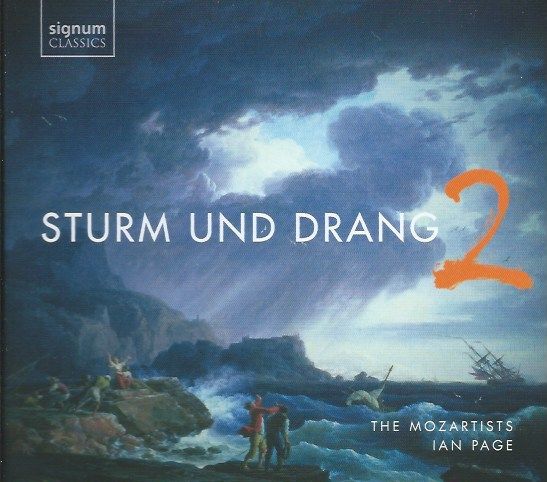More Sturm und Drang from The Mozartists

A vigorous, bracing performance of a lesser-known Haydn Symphony opens this latest disc of Sturm und Drang music from The Mozartists: the G minor, No. 39 (1765). This is the second volume (of a projected seven) that concentrates on music composed between the early 1760s and the early 1780s: music of, as the German name suggests, "storm and stress"; proto-Romantic, perhaps. Certainly we hear the twin ideals of storm and stress in the first movement of the Symphony No. 39; so much so, this movement casts its shadow over not only the string-only Andante that follows but also the lovely oboe-dominated Menuet. A fiery Allegro di molto brings us back full circle to the intensity of the first movement. No wonder the symphony is sometimes known as the "Tempesta di mare" (storm at sea).
In the absence of the excellent, vivid performance fromThe Mozartists and Ian Page, here's a chance to hear the symphony in another period instrument performance, Il Giardino Armonico with Giovanni Antonini:
Ian Page's work with The Mozartists and Classical Opera has centred on bringing lesser-known works to our attention in carefully themed concerts; but it has also brought singers to our attention, too. Here we have the superb Swedish mezzo-soprano Ida Ränslöv, who sings two pairs of arias separating the symphonies on the disc. First, a pair of Gluck arias: "O del mio dolce ardar" and "Tutti qui mi sosprende ... Le balle immagini," both from Paride ed Elena (1770). Ränslöv's elegant expressivity in the first aria reflects the intense yet contained joy that Paris (Paride) feels on landing at Sparta and breathing the same air as Helen; the sophisticated, emotionally complex "Tutti qui mi sosprende ... Le balle immagini" is more interior, Gluck's music speaking volumes through what on the surface appears as simplicity. In the absence of Ränslöv, let's hear Anne Sofie von Otter with The English Concert and Trevor Pinnock in "O del mio dolce ardar":
Here's Ida Ränslöv herself explaining her reactions to this music, and working with the inspirational Ian Page (the video also includes brief snippets of the pieces):
The second symphony on the disc is by the Bohemian composer Johann Baptist Vanhal (1739-1813), another minor key piece (D minor this time), probably composed before 1771. It both mirrors and extends the Haydn heard earlier: the first movement is absolutely unremitting in its verve. The second movement arioso spins a melody worthy of Haydn himself as well as revealing a gentilité to its wind writing. Here's a performance of the entire symphony, by Concerto Köln:
The second pair of vocal item come from Haydn ("Fac me vere tecum flere" from the Stabat Mater) and - joy of joys - some Mysliveček, "Tu mi disprezzi, ingrata" from his opera Semiramide. The almost impossibly beautiful Haydn (marked "lagrimoso") acts as a gateway into Haydn's 1767 masterpiece. Here's a performance with countertenor James Hall to give you an idea (with the Academy of Ancient Music):
I do wonder why, with the exception of Die Schöpfung/The Creation, we don' hear more of Haydn's sacred music as a matter of course. If the excerpt above sends you scurrying to hear the whole piece, why not try the wonderful so-called "Nelson Mass" after that - dramatic and beautiful by turns.
The Mysliveček aria was performed, alongside other arias from Semiramide, at a Wigmore Hall concert in September 2016, but there with another singer. Tamiri's aria is a song of a scorned woman, full of G minor fury; the perfect complement to the devout Haydn!.
It is, I would say, impossible not to like the music of J. C. Bach, eleventh surviving child of J. S.. That's Johann Christian, the so called "London Bach". His Op. 6 Symphonies have long been popular - I remember learning the Op. 6 set from an LP many years ago, which performance certainly was not as stylishly played as this one. There is an exquisite "cleanliness" about J. C.'s writing, and yet sometimes, as here, he finds real fire in his belly. The central slow movement (there are only three movements) melds the lachrymose minor-key with a tender, gentle demeanour in an alchemical combination that is entirely characteristic of this composer. Here' s the Akademie für Alte Musik, Berlin in this gorgeous movement:
That Andante is the clear focus of the symphony, at nearly eight minutes (the first is three minutes, the finale two and a half).
Sturm und Drang, Volume 2, is released today, Friday October 9, 2020 on the Signum label. There is superb sound from Producer and Engineer Andrew Mellor, who captures the acoustic of St John's, Smith Square to perfection. This is an invigorating disc that, let's not forget, introduces a singer, Ida Ränslöv, who is surely destined for great things.
